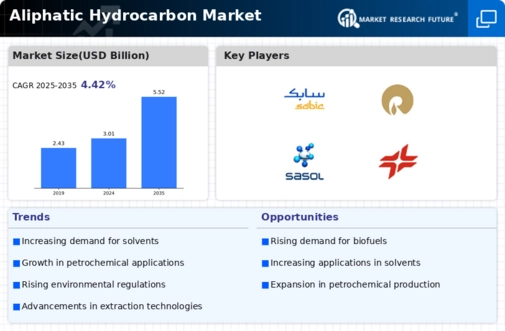Top Industry Leaders in the Aliphatic Hydrocarbon Market

Aliphatic hydrocarbons, organic compounds formed by single-bonded carbon and hydrogen chains, form the backbone of various industries. Their applications range from paints and coatings to fuels and solvents, making the aliphatic hydrocarbon market a dynamic and competitive space. Here's a comprehensive analysis of the current landscape, exploring strategies, market share drivers, industry news, and recent developments:
Market Share Drivers:
Application Diversification: Growing demand for aliphatic hydrocarbons in diverse sectors like construction, automotive, and consumer goods fuels market expansion. Players focusing on innovative applications gain an edge.
Regional Dynamics: Asia-Pacific leads the market, driven by rapid urbanization and infrastructure development. Emerging economies like India and China see substantial growth, attracting investments.
Sustainability Push: Environmental concerns drive investments in bio-based aliphatic hydrocarbons, offering a renewable alternative to fossil fuel-derived options. Companies embracing sustainability initiatives stand out.
Technological Advancements: Advancements in extraction and processing technologies improve efficiency and reduce costs, making aliphatic hydrocarbons more competitive. Players investing in R&D gain a technological advantage.
Regulatory Landscape: Stringent environmental regulations on volatile organic compounds (VOCs) in paints and coatings pose challenges for traditional aliphatic hydrocarbons. Companies developing low-VOC options gain market share.
List of Strategies Adopted by Key Players:
Mergers and Acquisitions: Major players like Exxon Mobil and Shell are consolidating their positions through acquisitions, expanding their regional reach and product portfolios.
Vertical Integration: Companies like SABIC are integrating upstream and downstream operations, gaining control over the supply chain and cost competitiveness.
Product Diversification: Expanding into adjacent markets like high-performance polymers and specialty chemicals opens up new avenues for growth. Reliance Industries' foray into polymers is an example.
Regional Focus: Tailoring product offerings and marketing strategies to specific regional needs, like developing heat-resistant aliphatic hydrocarbons for construction in hot climates, helps players carve out a niche.
Sustainability Initiatives: Investing in bio-based aliphatic hydrocarbons and developing closed-loop recycling systems attracts environmentally conscious customers and investors. LyondellBasell's bio-based polyethylene production is a noteworthy example.
List of Key Players in the Aliphatic Hydrocarbon Market:
- Exxon Mobil Corporation (US),
- SK global chemical Co., Ltd. (South Korea),
- Royal Dutch Shell PLC (Netherlands),
- SABIC (Saudi Arabia),
- LyondellBasell Industries Holdings B.V. (Netherlands),
- Reliance Industries Limited (India),
- China Petroleum & Chemical Corporation (China),
- Chevron Phillips Chemical Company (US),
- Total (France),
- Mitsubishi Chemical Corporation (Japan),
- Sasol (South Africa),
- Cepsa (Spain),
- Westlake Chemical Corporation (US).
Recent Developments:
August 2023: The Asia-Pacific region continues to dominate the market with the largest consumption, driven by rapid infrastructure development and urbanization (Mordor Intelligence).
September 2023: Concerns about rising crude oil prices and potential disruptions in the supply chain raise concerns about price volatility in the aliphatic hydrocarbon market.
October 2023: Increased focus on sustainability leads to a surge in demand for bio-based aliphatic hydrocarbons, with several new players entering the market.
November 2023: Technological advancements in bio-based production methods offer promising cost reductions and increased scalability for bio-based aliphatic hydrocarbons.
December 2023: The aliphatic hydrocarbon market is expected to benefit from increased government investments in infrastructure projects, particularly in developing economies.









